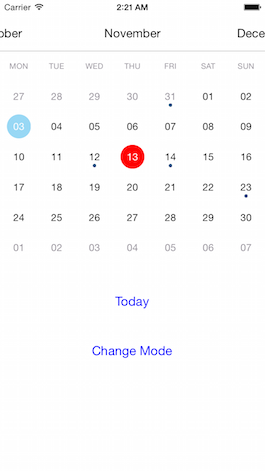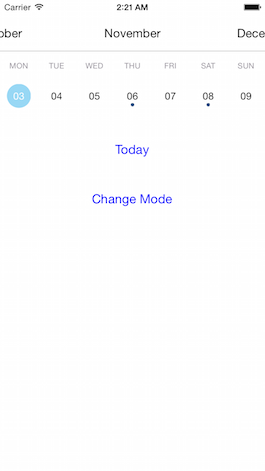JTCalendar is a calendar control for iOS easily customizable.
With CocoaPods, add this line to your Podfile.
pod 'JTCalendar', '~> 1.0.0'
You have to create two views in your UIViewController.
The first view is JTCalendarMenuView, it represents the months.
The second view is JTCalendarContentView, the calendar itself.
Your UIViewController must implement JTCalendarDataSource
#import <UIKit/UIKit.h>
#import "JTCalendar.h"
@interface ViewController : UIViewController<JTCalendarDataSource>
@property (weak, nonatomic) IBOutlet JTCalendarMenuView *calendarMenuView;
@property (weak, nonatomic) IBOutlet JTCalendarContentView *calendarContentView;
@property (strong, nonatomic) JTCalendar *calendar;
@endJTCalendar is used to coordinate calendarMenuView and calendarContentView.
@implementation ViewController
- (void)viewDidLoad
{
[super viewDidLoad];
self.calendar = [JTCalendar new];
[self.calendar setMenuMonthsView:self.calendarMenuView];
[self.calendar setContentView:self.calendarContentView];
[self.calendar setDataSource:self];
}
- (void)viewDidAppear:(BOOL)animated
{
[super viewDidAppear:animated];
[self.calendar reloadData]; // Must be call in viewDidAppear
}
- (BOOL)calendarHaveEvent:(JTCalendar *)calendar date:(NSDate *)date
{
return NO;
}
- (void)calendarDidDateSelected:(JTCalendar *)calendar date:(NSDate *)date
{
NSLog(@"%@", date);
}
@end
If you want see just one week at time you can switch when you want between the weekMode.
self.calendar.calendarAppearance.isWeekMode = YES;
[self.calendar reloadAppearance];When you change the mode, it doesn't change the height of calendarContentView, you have to do it yourself.
See the project in example for more details.
You have a lot of options available for personnalize the design.
Check the JTCalendarAppearance.h file for see all options.
self.calendar.calendarAppearance.calendar.firstWeekday = 2; // Monday
self.calendar.calendarAppearance.ratioContentMenu = 1.;
self.calendar.calendarAppearance.menuMonthTextColor = [UIColor whiteColor];
self.calendar.calendarAppearance.dayCircleColorSelected = [UIColor blueColor];
self.calendar.calendarAppearance.dayTextColorSelected = [UIColor whiteColor];
[self.calendar reloadAppearance];The call to reloadAppearance is expensive, reloadAppearance is call by setMenuMonthsView and setContentView.
For better performance define the appearance just after instanciate JTCalendar.
BAD example:
self.calendar = [JTCalendar new];
[self.calendar setMenuMonthsView:self.calendarMenuView];
[self.calendar setContentView:self.calendarContentView];
[self.calendar setDataSource:self];
self.calendar.calendarAppearance.calendar.firstWeekday = 2; // Monday
self.calendar.calendarAppearance.ratioContentMenu = 1.;
self.calendar.calendarAppearance.menuMonthTextColor = [UIColor whiteColor];
self.calendar.calendarAppearance.dayCircleColorSelected = [UIColor blueColor];
self.calendar.calendarAppearance.dayTextColorSelected = [UIColor whiteColor];
[self.calendar reloadAppearance]; // You have to call reloadAppearanceGOOD example:
self.calendar = [JTCalendar new];
self.calendar.calendarAppearance.calendar.firstWeekday = 2; // Monday
self.calendar.calendarAppearance.ratioContentMenu = 1.;
self.calendar.calendarAppearance.menuMonthTextColor = [UIColor whiteColor];
self.calendar.calendarAppearance.dayCircleColorSelected = [UIColor blueColor];
self.calendar.calendarAppearance.dayTextColorSelected = [UIColor whiteColor];
[self.calendar setMenuMonthsView:self.calendarMenuView];
[self.calendar setContentView:self.calendarContentView];
[self.calendar setDataSource:self];
// You don't have to call reloadAppearanceYou may also want to open your calendar on a specific date, by defaut it's [NSDate date].
[self.calendar setCurrentDate:myDate];- iOS 7 or higher
- Automatic Reference Counting (ARC)
JTCalendar is released under the MIT license. See the LICENSE file for more info.





